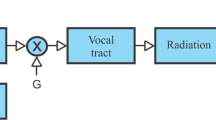Abstract
Port Hamiltonian systems (PHS) are open passive systems that fulfil a power balance: they correspond to dynamical systems composed of energy-storing elements, energy-dissipating elements and external ports, endowed with a geometric structure (called Dirac structure) that encodes conservative interconnections. This paper presents a minimal PHS model of the full vocal apparatus. Elementary components are: (a) an ideal subglottal pressure supply, (b) a glottal flow in a mobile channel, (c) vocal-folds, (d) an acoustic resonator reduced to a single mode. Particular attention is paid to the energetic consistency of each component, to passivity and to the conservative interconnection. Simulations are presented. They show the ability of the model to produce a variety of regimes, including self-sustained oscillations. Typical healthy or pathological configuration laryngeal configurations are explored.
Access this chapter
Tax calculation will be finalised at checkout
Purchases are for personal use only
Similar content being viewed by others
References
van den Berg, J.: On the air resistance and the Bernoulli effect of the Human Larynx. J. Acous. Soc. Am. 29(5), 626–631 (1957)
van der Schaft, A., Jeltsema, D.: Port-Hamiltonian Systems Theory: an Introductory Overview. Now Publishers Inc., Hanover (2014)
Encina, M., et al.: Vocal fold modeling through the port-Hamiltonian systems approach. In: IEEE Conference on Control Applications (CCA), pp. 1558–1563 (2015)
Maschke, B., et al.: An intrinsic Hamiltonian formulation of network dynamics: non-standard Poisson structures and gyrators. J. Frankl. Inst. 329(5), 923–966 (1992)
Flanagan, J., Landgraf, L.: Self-oscillating source for vocal-tract synthesizers. IEEE Trans. Audio Electroacous. 16(1), 57–64 (1968)
Awrejcewicz, J.: Numerical analysis of the oscillations of human vocal cords. Nonlinear Dyn. 2, 35–52 (1991)
Lopes, N., Hélie, T.: Energy balanced model of a jet interacting with a brass player’s lip. Acta Acust United Acust. 102(1), 141–154 (2016)
Lopes, N.: Approche passive pour la modélisation, la simulation et l’étude d’un banc de test robotisé pour les instruments de type cuivre. Ph.D. thesis, UPMC, Paris (2016)
Falaize, A.: PyPHS: passive modeling and simulation in python. Software. https://afalaize.github.io/pyphs/. last viewed on 21st April 2017
Badin, P., Fant, G.: Notes on vocal tract computation. STL-QPSR 25(2–3), 53–108 (1984)
Giovanni, A., et al.: Nonlinear behavior of vocal fold vibration: the role of coupling between the vocal folds. J. Voice 13(4), 465–476 (1999)
Acknowledgement
The first author acknowledges the support of the Collaborative Research DFG and ANR project INFIDHEM ANR-16-CE92-0028.
Author information
Authors and Affiliations
Corresponding author
Editor information
Editors and Affiliations
A Dynamics of the glottal flow
A Dynamics of the glottal flow
The dynamics for the mean velocities can also be derived from the volume integration of the Euler equation (4). Using the gradient theorem, it comes that
The energy balance for the glottal flow writes down as:
where n is the outgoing normal. As the normal velocity is uniform on the walls, the last term of the energy balance reduces to
The same applies on \(S^-\cup S^+\) where \(v\cdot n = \pm v_x(x=\pm \ell )\) does not depend on y:
Thus, \( \displaystyle \dot{\varepsilon } = \dot{y}_m\left( F_r^p-F_l^p\right) -\frac{\dot{h}}{2}\left( F_r^p+F_l^p\right) + L h(t) v_0\left( P_{tot}^- - P_{tot}^+\right) + L \ell \dot{h} \left( P_{tot}^- + P_{tot}^+\right) \). In the meanwhile, the kinetic energy in Eq. (6) can be derived against time: \( \displaystyle \dot{\varepsilon } = m(h)\left( v_0\dot{v}_0 + \dot{y}_m\ddot{y}_m\right) + m_3(h)\dot{h}\ddot{h} +\frac{\partial H}{\partial h}\dot{h}\). The identification of the contribution of the mean axial and transverse velocities (see Eq. (8)) leads to the dynamics of the glottal channel expansion rate :
Rights and permissions
Copyright information
© 2017 Springer International Publishing AG
About this paper
Cite this paper
Hélie, T., Silva, F. (2017). Self-oscillations of a Vocal Apparatus: A Port-Hamiltonian Formulation. In: Nielsen, F., Barbaresco, F. (eds) Geometric Science of Information. GSI 2017. Lecture Notes in Computer Science(), vol 10589. Springer, Cham. https://doi.org/10.1007/978-3-319-68445-1_44
Download citation
DOI: https://doi.org/10.1007/978-3-319-68445-1_44
Published:
Publisher Name: Springer, Cham
Print ISBN: 978-3-319-68444-4
Online ISBN: 978-3-319-68445-1
eBook Packages: Computer ScienceComputer Science (R0)




